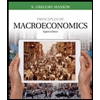1.) An economic indicator is procyclical if it rises when the economy is expanding and falls during recessions, countercyclical if it falls when the economy is expanding and rising during recessions, and lagging if it changes only after the economy has begun to follow a particular trend. Interest rates (remain the same, increase, decrease) when there is a business cycle expansion. Therefore, interest rates are said to be (procyclical, lagging, countercyclical). 2.) Using the liquidity preference framework, when the economy expands, A. the demand for money will decrease, shifting the money demand curve to the right. B. the demand for money will decrease, shifting the money demand curve to the left. C. the demand for money will increase, shifting the money demand curve to the left. D. the demand for money will increase, shifting the money demand curve to the right.
1.) An economic indicator is procyclical if it rises when the economy is expanding and falls during recessions, countercyclical if it falls when the economy is expanding and rising during recessions, and lagging if it changes only after the economy has begun to follow a particular trend.
Interest rates (remain the same, increase, decrease) when there is a business cycle expansion. Therefore, interest rates are said to be (procyclical, lagging, countercyclical).
2.) Using the liquidity preference framework, when the economy expands,
A.
the
B.
the demand for money will decrease, shifting the money demand curve to the left.
C.
the demand for money will increase, shifting the money demand curve to the left.
D.
the demand for money will increase, shifting the money demand curve to the right.

Step by step
Solved in 4 steps









